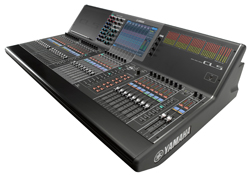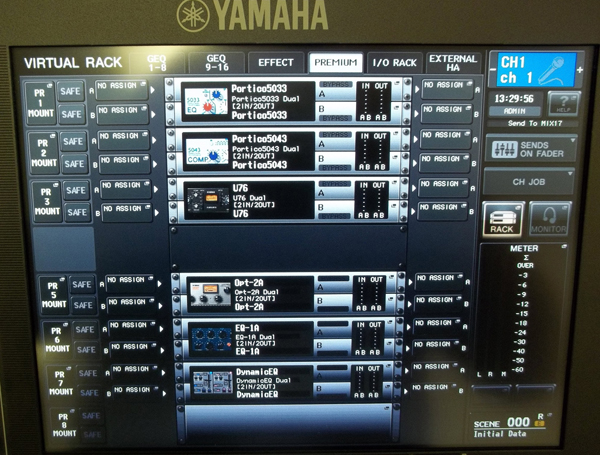
The right side of the console contains the last channel bank that allows control of DCA layers, Stereo ins, or six Custom layers.
The far right of the surface sports the master section that includes two faders, each with ON, CUE, SELECT, meters and a rotary knob.
The master faders are also customizable able to become inputs, outputs, DCAs, etc. The front face is outfitted with a headphone jack with volume, as well as a talkback XLR input with level knob.
On the rear panel, there are eight omni XLR mic/line inputs, eight omni XLR outputs, the mini-YGDAI I/O card slots, an AES/EBU digital output, 15-pin GPI connector, two BNC connectors for word clock in/out, MIDI in/out, a pair of Ethercon connectors for the Dante network, an RJ connector for the computer network connection, and XLR lamp connectors.
A locking IEC connector is supplied for power but the CL5 also sports a multi-pin connector for the optional (PW800W) backup power supply.
If the internal power supply has a problem, the PW800 will seamlessly take over.
First Impression
Overall the CL5 has a great look and feel. The fader caps are a new design from Yamaha and are very comfortable, and all the knobs are well laid out and easy to reach. The buttons, knobs and faders have a solid feel and should last for a long time.
Further, the user interface is easy to learn and get around on without spending a lot of time in the manual. The touchscreen allows multiple button selection by simply sliding your finger across the screen, and rotary knobs can be depressed to recall a screen.
The console offers a few new tools, including a premium rack that features VCM analog circuit modeling technology, and some Rupert Neve Designs EQ and compressors.
For my evaluation, Yamaha also sent along a RIO3224-D stage box. This unit provides 32 inputs and 16 outputs via XLR, as well as four AES/EBU outputs in a 5RU package. The stage box offers both a Dante primary and secondary connection point that allows daisy chaining additional boxes or the ability to connect a network in a redundant fashion.
In The Field
After checking out the console in my shop and getting comfortable with the patching, I took it out on some gigs. The first was the typical corporate type show for my company, a few presenters with some playback. With all of it’s capabilities, the CL5 was overkill, but the smaller CL1 would be perfect for these smaller (but high end) types of events.
Because I was using only one hardwired microphone as a podium backup, I didn’t feel the need to use the Rio stage box and operated the console as a stand-alone desk. I patched the Omni inputs into some channels and placed the wireless rack next to me at front of house.

